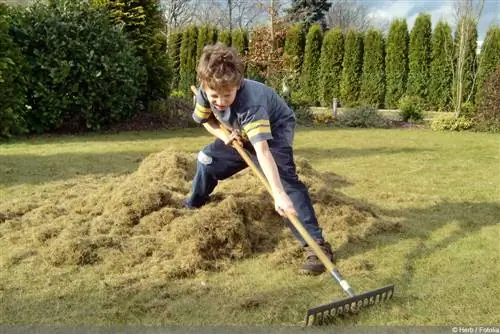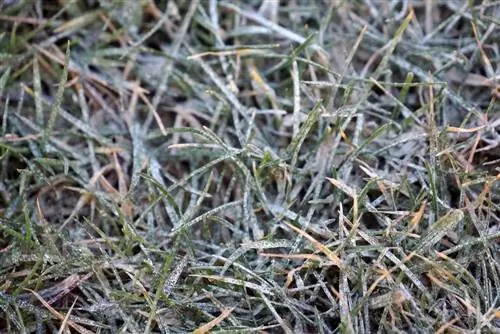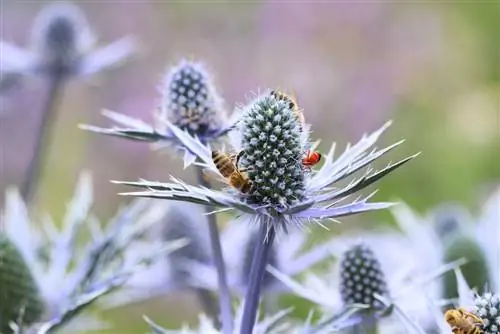- Author admin [email protected].
- Public 2023-12-17 03:39.
- Last modified 2025-01-24 12:45.
If you want to level your garden, there are various methods that are easy to implement and do not require heavy equipment. The tips presented here will help you with this project.
Determine height difference
Before you can level the area, you must determine and visualize the height difference. This is especially true for garden floors and lawns that are very uneven and need to be completely straightened. The height difference can be found using the following tools:
- Wooden posts for each area corner point
- string
- Spirit level
- Lot
- Inch ruler or tape measure
It won't hurt if you also have a pen and paper or your smartphone available when you measure the height. This allows you to take notes, making leveling easier. Then proceed as follows:
- Stake out the area with wooden posts
- Stretch cords between the posts
- Align the cords with a spirit level
- hang the plumb bob on the string
- select the highest point for it
- Note the distance from the cord to the ground
- now select the lowest point
- Note the distance from the cord to the ground
- choose a value between the points
- this represents the desired final height of the area
Straightening the floor: 5 tips
Prepare the area
While you rarely have to repair something before straightening on lawns, this is a different case with garden floors. The soils may contain numerous obstacles that make it impossible to level the surface. Especially when you have to remove the surface, various materials and utensils pose a problem. For this reason, remove all unnecessary obstacles:
- Stones of any size
- Plant parts such as roots or branches
- Weeds
- Furniture
- Waste
- Tools
- Building materials
- Bulky waste
Tip:
When preparing, be sure to consider native plants that are difficult to transplant. Either move these as carefully as possible or work around the plant.
Compensate holes
Imperfections need to be leveled out to level the soil in your garden. If you're lucky, it's enough to make the surface as flat as possible in this way. Unevenness primarily refers to holes that have arisen over the years due to long-term stress. If the rest of the surface is straight, you don't need to use any other methods. For this reason, this tip is particularly suitable as a small “beauty treatment” for the floors:
- Fill holes with new material
- condense by hand
- fill in additional material
- condense again
- Repeat steps until desired height is reached
- use garden soil to fill up
- enrich with quartz sand or gravel
- protects against compaction
Note:
The ideal time for straightening soils and lawns is in spring from April to early June. To make your work easier, choose a day when the ground is not frozen or too wet.
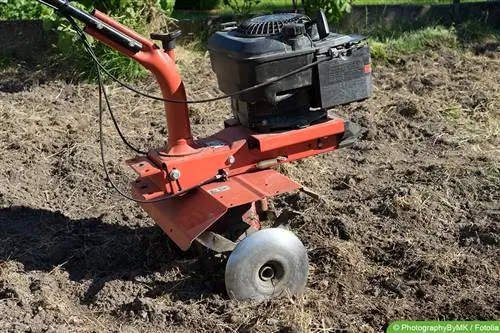
Redistribute excavated earth
If you are not dealing with holes but with numerous, uneven areas, you should restructure the entire top layer of soil. This saves you the time-consuming straightening of individual areas and allows you to tackle the entire area, which is particularly recommended for small properties. This tip can also be used for garden soils that are significantly too high or for slopes that need to be adjusted. You will need the following utensils:
- Spade
- Shovel
- vibration plate
- Work gloves
- sturdy shoes
- Stead
If the soil in your region is rocky, you should also have a pickaxe available. You can rent vibrating plates from hardware stores for a daily fee of 25 euros to 50 euros. Once you have all the utensils available, do the following:
- Remove the turf completely, if present
- Dispose of the sod afterwards
- Remove surface to desired depth
- use a spade and shovel for this
- Mix the excavated earth thoroughly
- optionally use topsoil
- Excavated earth can be sieved beforehand
- spread a layer of excavated earth on the area
- condense
- repeat until desired height is reached
- Remove loose excess with a straightedge
- optional: incorporate drainage material (quartz sand, gravel)
- then peel off again
Reels
If you only need to repair small imperfections, you can use a roller. This can be used to thoroughly level the floor. To do this, choose a hand roller that weighs at least 50 kilograms. It doesn't matter whether it is filled with sand or water. Hand rollers can be rented for around 15 euros per day.
Do the following:
- Remove and dispose of sod
- Calculate the area thoroughly
- Guide the roller in tracks over the surface
- Take curves as tight as possible
- use the roller until the floor is level
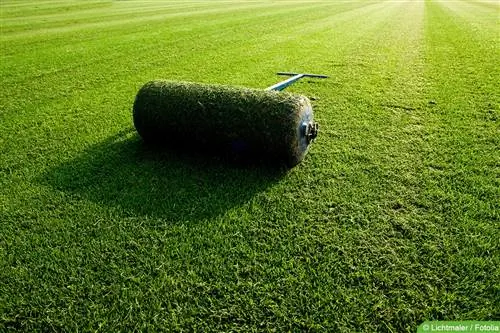
Use foundation
Another way to make the garden floor a flat surface is to use a foundation. If you don't want to plant the garden, but want to use it for garden furniture, for grilling or for placing potted plants, this method is ideal. In most cases, it is sufficient to pour a slab foundation or lay concrete slabs. Even a garden house can be placed on these. In terms of dimensions, refer to the marked area.
Leveling the lawn: 5 tips
Fill in small bumps
This method is a bit reminiscent of filling the holes in a garden floor. However, it is not applied in the same way as the lawn is not compacted after filling. The small bumps still have grasses that continue to grow. For this reason, the freshly filled substrate must not be compacted. To top up, choose fresh topsoil enriched with a little quartz sand. Finally, water well and after a few weeks the area will be completely sealed and accessible again. Reseeding is not necessary.
Repair elevations
If the affected areas are no longer small and the entire area is uneven, you should completely restructure it. This method is particularly suitable for leveling large lawns.
All you need is the right equipment:
- Lawnmower
- Scarifier
- Spade
- Shovel
- Work gloves
If your lawn is very large, a helping hand is recommended. The method is quite strenuous as you dig up a large part of the area. The following points explain the process:
- mowing the lawn
- then scarify
- if necessary: remove and dispose of old turf in certain places
- Remove unevenness afterwards
- Reduce compactions
- optional: dig up the entire lawn
- Let the lawn rest for a few days
- then sprinkle the lawn with a layer of topsoil
- let it rest again
- pave with roller or running boards
- finally fertilize thoroughly
Use running boards
Treadboards are another tip for straightening your lawn. The principle is the same as with the roller mentioned above, only you are the weight. Of course, you could use the roller in the same way for the lawn, but sometimes the boards are sufficient. This variant is particularly recommended for smaller lawns. To do this, you put on the boards, fix them in place and walk in straight paths across the entire lawn. This continues until the surface has been straightened.
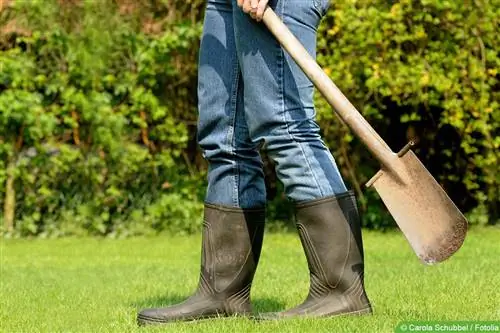
Repair individual areas
Rarely it can happen that a single piece of the lawn is uneven. In this case, you have to repair the relevant areas, which is done with the help of a lawn edger:
- Find unevenness
- Work on the spot with a lawn edger in an X
- starting from the center of the bump
- do not separate the resulting pieces from the rest of the lawn
- Fold the lawn pieces outwards
- now the ground is revealed
- loose up thoroughly
- remove too much earth
- Surface must be straight
- press the earth with a little force
- Fold lawn pieces back
- water if necessary
Very important: lawn seeds
One of the most important points after straightening the lawn is to sow new lawn seeds. These are used to repair bare spots that appeared during leveling. In most cases it is sufficient if you sprinkle the affected areas with seeds over a large area and moisten them. After a few weeks the first grasses will appear and the lawn will close again over time. Do not put any strain on the relevant areas during the growing season.


